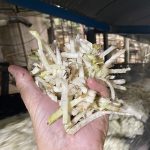 In early spring, farmers in Michigan and Ontario plant sugarbeet seeds in rich soil. Rain, sun, fertilizer, and proper seedbed preparation help the seeds develop into enormous sugarbeets with large, white taproots. Young sugarbeet seedlings have many challenges to overcome in the four to six months that it takes to become a mature crop.
In early spring, farmers in Michigan and Ontario plant sugarbeet seeds in rich soil. Rain, sun, fertilizer, and proper seedbed preparation help the seeds develop into enormous sugarbeets with large, white taproots. Young sugarbeet seedlings have many challenges to overcome in the four to six months that it takes to become a mature crop.
 The weather is very important to sugarbeets. If the soil is too dry, the seeds will not germinate. Heavy rains can drown out the sugarbeets. Freezing weather also can kill small seedlings. After planting, growers hope for warm weather and soft rains of about 1 inch per week. Strong winds can cause the sugarbeets to twist and turn, and along with blowing soil, the sugarbeets can be cut in half by the wind. Sugarbeet growers have learned different ways to help combat the weather, but occasionally the crop can be lost or severely damaged.
The weather is very important to sugarbeets. If the soil is too dry, the seeds will not germinate. Heavy rains can drown out the sugarbeets. Freezing weather also can kill small seedlings. After planting, growers hope for warm weather and soft rains of about 1 inch per week. Strong winds can cause the sugarbeets to twist and turn, and along with blowing soil, the sugarbeets can be cut in half by the wind. Sugarbeet growers have learned different ways to help combat the weather, but occasionally the crop can be lost or severely damaged.
 After sugarbeets get a little bigger, about 6-12 inches tall, they are able to wishstand harsh weather and insect problems. By mid-summer, sugarbeets have leaves that are 1-2 feet tall and begin storing sugar in their roots.
After sugarbeets get a little bigger, about 6-12 inches tall, they are able to wishstand harsh weather and insect problems. By mid-summer, sugarbeets have leaves that are 1-2 feet tall and begin storing sugar in their roots.
 Sugarbeet harvest begins in the fall. A topping machine removes the giant leaves before the harvester moves through the fields, lifting the beets from the earth. Dirt is removed from the sugarbeets by shaking the beets using the harvester’s rollers. Large trucks drive beside the tractor to catch the beets once they are harvested.
Sugarbeet harvest begins in the fall. A topping machine removes the giant leaves before the harvester moves through the fields, lifting the beets from the earth. Dirt is removed from the sugarbeets by shaking the beets using the harvester’s rollers. Large trucks drive beside the tractor to catch the beets once they are harvested.
 Once the sugarbeets are loaded into trucks, they are taken to Michigan Sugar Company, and put into piles that are 20 feet high, 200 feet wide and more than 1,000 feet long. Many of the piles have larger fans that blow cold air into the piles to help the beets store outdoors for more than 100 days.
Once the sugarbeets are loaded into trucks, they are taken to Michigan Sugar Company, and put into piles that are 20 feet high, 200 feet wide and more than 1,000 feet long. Many of the piles have larger fans that blow cold air into the piles to help the beets store outdoors for more than 100 days.
 The sugarbeets are floated into the factories and stones, that are brought in with them during harvest, are separated out. Next, the beets are washed and fed into a machine that slices the beets into long, skinny pieces called cossettes that resemble shoestring potatoes. These slices are perfect for extracting the sugar from the beet.
The sugarbeets are floated into the factories and stones, that are brought in with them during harvest, are separated out. Next, the beets are washed and fed into a machine that slices the beets into long, skinny pieces called cossettes that resemble shoestring potatoes. These slices are perfect for extracting the sugar from the beet.
 The cossettes are dumped into a very large tank filled with hot water called a diffuser. As the cossettes move through the diffuser, the sugar comes out of the beets and goes into a solution of sugar water. Filters and natural cleansers of lime and carbon dioxide remove any impurities. The remaining, de-sugared cossettes will be turned into a co-product that makes an excellent animal feed – pulp.
The cossettes are dumped into a very large tank filled with hot water called a diffuser. As the cossettes move through the diffuser, the sugar comes out of the beets and goes into a solution of sugar water. Filters and natural cleansers of lime and carbon dioxide remove any impurities. The remaining, de-sugared cossettes will be turned into a co-product that makes an excellent animal feed – pulp.
 Juice from the purification step is quite thin and consists of much water. The majority of this water is removed by heating the thin juice and boiling it off until the juice becomes considerably thicker. This evaporator station consists of several vessels containing thousands of tubes. Boilers produce steam, which is applied to the outside of the evaporator tubes while the juice passes through the inside. After being filtered again, the juice is thick enough that crystals form and the thickened juice from evaporation is now ready to have the crystalized sugar separated from the concentrated juice.
Juice from the purification step is quite thin and consists of much water. The majority of this water is removed by heating the thin juice and boiling it off until the juice becomes considerably thicker. This evaporator station consists of several vessels containing thousands of tubes. Boilers produce steam, which is applied to the outside of the evaporator tubes while the juice passes through the inside. After being filtered again, the juice is thick enough that crystals form and the thickened juice from evaporation is now ready to have the crystalized sugar separated from the concentrated juice.
 The crystallized sugar is spun around at high speeds in a centrifuge machine, removing the molasses that did not crystallize. The damp sugar then tumbles through hot, filtered air to dry. The dry sugar is cooled and conditioned and then stored in a sugar silo for subsequent packaging or shipment in bulk trucks or railcars.
The crystallized sugar is spun around at high speeds in a centrifuge machine, removing the molasses that did not crystallize. The damp sugar then tumbles through hot, filtered air to dry. The dry sugar is cooled and conditioned and then stored in a sugar silo for subsequent packaging or shipment in bulk trucks or railcars.
 The sugar is packaged in smaller Pioneer Sugar bags in 2-, 4-, 10-, and 25-pound sizes. The bags are delivered to grocery stores throughout Michigan and the Midwest. Some of our sugar is packed in larger bags and totes holding 25, 50, 100, or 2,000 pounds. These are delivered to various food manufacturers who make cereal, yogurt, cookies and other sweet treats.
The sugar is packaged in smaller Pioneer Sugar bags in 2-, 4-, 10-, and 25-pound sizes. The bags are delivered to grocery stores throughout Michigan and the Midwest. Some of our sugar is packed in larger bags and totes holding 25, 50, 100, or 2,000 pounds. These are delivered to various food manufacturers who make cereal, yogurt, cookies and other sweet treats.

Pioneer Sugar is the brand of Michigan Sugar Company, a cooperative owned by nearly 900 farmers from Michigan and Ontario, Canada. The company has been extracting pure, all-natural sugar from sugarbeets since 1906. We are proud of our past and excited about our future. Learn more about our company at www.michigansugar.com.